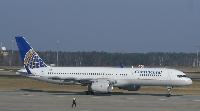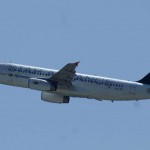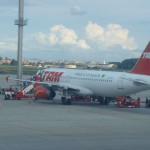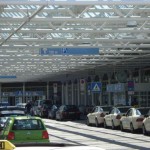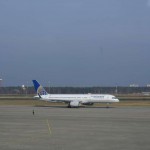Record fuel prices lead to quarterly loss; Continental to shrink domestic mainline capacity 5.0 percent on an annual run-rate basis; company to retire 14 additional mainline aircraft; Continental redeems Northwest’s Golden Share
Houston – Continental Airlines (NYSE: CAL) today reported a first quarter 2008 net loss of $80 million ($0.81 diluted loss per share). Excluding a $5 million after tax gain from the sale of aircraft, Continental recorded a net loss of $85 million ($0.86 diluted loss per share).
Fuel costs increased 53.2 percent ($364 million) in the first quarter compared to the first quarter of last year, with crude oil prices peaking at $110.33 per barrel and Gulf Coast jet fuel peaking at $139.67 per barrel during the quarter. Further, during the quarter, the company incurred additional fuel costs of $69 million year-over-year that were included as part of its regional capacity purchase cost. As a result, the total year-over-year impact of higher fuel costs on the company for the first quarter was $433 million.
Continental plans to remove from service an additional 14 older, less fuel efficient 737-300 aircraft as leases expire on those aircraft from September 2008 to April 2009. These 14 737-300s are in addition to the 34 737-300s and 500s that were already planned to be removed from service in 2008 and 2009.
Continental also expects to reduce regional jet capacity beginning in the fall 2008; however, its plans are fluid as it is attempting to negotiate better economics with ExpressJet, and as the CRJs flown for Continental by Chautauqua come off lease.
„Thanks to the continued hard work and dedication of my co-workers, we ran a solid operation despite extremely challenging times,“ said Larry Kellner, Continental’s chairman and chief executive officer. „In this rapidly changing competitive environment, we will stay focused on running a clean, safe and reliable airline with the best customer service in the industry.“
First Quarter Revenue and Capacity
Total revenue for the quarter of $3.6 billion increased 12.3 percent ($391 million) over the same period in 2007 as a result of increased fuel surcharges on passenger tickets and cargo, international growth and modest fare increases. Passenger revenue grew 11.3 percent ($328 million) compared to the first quarter of last year, an increase in all geographic regions.
As a result of record high fuel prices, a weakening economy and a weak dollar, Continental plans to reduce domestic mainline capacity 5.0 percent on an annual run-rate basis beginning this fall. Continental expects that its 2008 mainline capacity, including international growth, will increase about 2.0 percent, and that its 2009 mainline capacity, including international growth, will be approximately flat compared to 2008.
Consolidated revenue passenger miles (RPMs) for the quarter increased 3.9 percent year-over-year on a capacity increase of 4.1 percent, resulting in a first quarter consolidated load factor of 78.5 percent, 0.2 points below the previous first quarter record set in 2007. Consolidated yield for the quarter increased 7.2 percent year-over-year. Consolidated revenue per available seat mile (RASM) for the quarter increased 7.0 percent year-over-year due to increased yields.
Mainline RPMs in the first quarter of 2008 increased 4.4 percent over the first quarter 2007, on a capacity increase of 4.8 percent. Mainline load factor was 78.8 percent, down 0.3 points year-over-year. Continental’s mainline yield increased 7.2 percent over the same period in 2007. As a result, first quarter 2008 mainline RASM was up 6.7 percent over the first quarter of 2007.
Passenger revenue for the first quarter of 2008 and period-to-period comparisons of related statistics by geographic region for the company’s mainline operations and regional operations are as follows:
Percentage Increase (Decrease) in
First Quarter 2008 vs. First Quarter 2007
Passenger
Revenue Passenger
(in millions) Revenue RASM ASMs
Domestic $1,355 7.6 % 8.3 % (0.7)%
Trans-Atlantic 606 20.6 % 2.8 % 17.2 %
Latin America 462 14.4 % 6.7 % 7.2 %
Pacific 257 12.0 % 8.8 % 2.9 %
Total Mainline $2,680 11.9 % 6.7 % 4.8 %
Regional $543 8.7 % 9.8 % (0.9)%
Consolidated $3,223 11.3 % 7.0 % 4.1 %
First Quarter Operational Accomplishments
Continental employees earned $6 million in cash incentives for twice finishing in the top three of the network carriers for monthly on-time performance during the quarter. The carrier recorded a U.S. Department of Transportation (DOT) on-time arrival rate of 71.0 percent and a systemwide mainline segment completion factor of 98.9 percent for the quarter.
Continental was again rated the top airline on FORTUNE magazine’s annual airline industry list of World’s Most Admired Companies. This is the fifth consecutive year that Continental has topped that list. The airline also ranked No. 41 on FORTUNE’s World’s Most Admired Companies „Top 50“ list, which ranks companies in a wide variety of industries. Continental was the only U.S. passenger carrier on the „Top 50“ list.
„Despite the incredibly difficult industry environment, our co-workers continued to deliver exceptional service, as our revenue results show,“ said Jeff Smisek, president of Continental. „However, in this fuel environment, we must reduce our domestic capacity to help reduce our losses in the domestic system.“
Launching the biggest operation of any of the new-entrant carriers at Heathrow under Open Skies on March 29, Continental began twice-daily nonstop widebody service to London/Heathrow from both its New York and Houston hubs, the largest overnight international service expansion in the company’s history. The airline continues to offer nonstop flights to London/Gatwick from New York (twice daily) and Houston (daily), as well as Cleveland (daily, seasonal).
During the quarter, Continental announced an agreement with LiveTV to offer 36 channels of live, satellite-based television programming at every seat on Continental’s next generation Boeing 737s and on its 757-300 aircraft. The service is expected to begin to be available to customers on flights operating within the continental United States beginning in January 2009. In addition, the company expects to introduce onboard Wi-Fi services including e-mail and instant messaging connectivity, as LiveTV is installed on those aircraft.
Financial Results
Continental’s mainline cost per available seat mile (CASM) increased 11.6 percent (down 0.3 percent holding fuel rate constant and excluding special items) in the first quarter compared to the same period last year. The company’s average price per mainline gallon of fuel, including fuel taxes, increased 47.6 percent year-over-year.
In the first quarter of 2008, the price of a barrel of West Texas Intermediate crude oil averaged almost $100 per barrel compared to less than $60 per barrel for the same period last year. Continental’s annualized fuel costs increase by approximately $45 million for each $1-per-barrel rise in the price of crude.
„As the price of fuel continues to skyrocket, in addition to capacity pull downs, we are implementing another round of cost reduction and revenue generating initiatives,“ said Jeff Misner, Continental’s executive vice president and chief financial officer. „These initiatives are expected to result in over $200 million of annual benefits when fully implemented.“
Continental’s young, fuel efficient fleet provides a natural hedge against rising jet fuel costs. The carrier is about 35 percent more fuel efficient per mainline revenue passenger mile than it was in 1997. With mainline RPMs up 4.4 percent for the quarter, mainline fuel consumption increased only 3.9 percent.
During the quarter, Continental installed winglets on eight of the company’s 737-500s and two 737-900 aircraft, and now has winglets on 229 of its mainline aircraft. All of the company’s 737-700s, 800s, 900ERs and 757-200s have winglets, as do select airplanes from Continental’s 737-300, -500 and -900 series fleets. Winglets increase aerodynamic efficiency and decrease drag, reducing fuel consumption and emissions by up to five percent.
Continental hedged approximately 22 percent of its fuel requirements for the first quarter of 2008, recording a gain of $29 million. As of March 31, 2008, the company had hedged approximately 18 percent of its projected fuel requirements for the second quarter of 2008 and five percent for the third quarter of 2008.
Continental ended the first quarter with approximately $2.5 billion in unrestricted cash and short-term investments.
Continental Redeems Northwest’s Golden Share
On April 14, 2008, Northwest Airlines and Delta Air Lines announced that they entered into a merger agreement. Northwest previously held a share of Continental preferred stock, known as the Golden Share, which prevented Continental from engaging in certain business combinations without Northwest’s consent. Continental was entitled to redeem the Golden Share for $100 upon a Northwest change in control, which occurred upon Northwest’s entry into a merger agreement with Delta. As a result, the company has redeemed the Golden Share.
Other Matters
Continental distributed $158 million of profit sharing to its employees on Feb. 14, 2008. In addition, co-workers who were granted stock options on March 30, 2005 were able to exercise the final one-third of their stock options beginning March 30, 2008. At yesterday’s closing stock price, the realized and unrealized gains from these options were over $100 million.
Continental contributed $60 million to its defined benefit pension plans during the first quarter of 2008. On April 10, 2008, the company contributed an additional $24 million and during the remainder of the year, expects to contribute an additional $80 million for a total of $164 million in contributions to its defined benefit pension plans during calendar year 2008. Although it had been Continental’s intent to fund its defined benefit pension plans above these levels, Continental currently believes it is prudent, due to record high fuel prices and other challenges facing the industry, to instead contribute a total of $164 million during calendar year 2008, which continues to exceed the company’s minimum funding requirement during such period.
During the quarter, the company took delivery of seven new Boeing 737-900ER aircraft, which have one of the lowest operating costs in the fleet and allow Continental to serve high demand markets more efficiently. The company also took delivery of three Boeing 737-800 aircraft in the quarter, and an additional 737-900ER aircraft in April 2008.
In 2008, Continental will take delivery of 32 new, fuel efficient 737-800s and 900ERs, and an additional 18 737s in 2009. In addition, Continental is taking delivery of two 777-200ERs in 2009.
Continental also introduced a new type of regional aircraft at Newark Liberty International Airport, the 74-seat Bombardier Q400. The Q400 is an ideal aircraft to operate at Liberty as it will allow more extensive use of alternate approach and departure routes and will enable flight operations at lower altitudes. It is also more fuel efficient per seat mile than the company’s regional jets.
Continental sold three 737-500 aircraft in the first quarter and received cash proceeds of $42 million, resulting in pre-tax gains of $8 million. Fourteen 737-500 aircraft are scheduled for delivery to purchasers by the end of 2008. The company has also entered into agreements to terminate the leases and arrange for the sale of eight additional leased Boeing 737-500 aircraft for delivery in 2009. All of these aircraft will be operated outside of the U.S.
During the quarter, the company announced that it had added 27 aircraft to its firm order positions with Boeing. At the end of the quarter, Continental had firm commitments for 106 new Boeing aircraft (25 Boeing 787s, eight Boeing 777s and 73 Boeing 737s) for delivery over the next six years, with options to purchase an additional 102 aircraft.
Continuing its commitment to the environment, Continental became the first major U.S. carrier, in conjunction with Boeing and GE Aviation, to announce plans to conduct a biofuels demonstration flight in the first half of 2009 in an effort to identify sustainable second generation biofuel solutions for the aviation industry.
Corporate Background
Continental Airlines is the world’s fifth largest airline. Continental, together with Continental Express and Continental Connection, has more than 3,100 daily departures throughout the Americas, Europe and Asia, serving 145 domestic and 138 international destinations. More than 550 additional points are served via SkyTeam alliance airlines. With more than 45,000 employees, Continental has hubs serving New York, Houston, Cleveland and Guam, and together with Continental Express, carries approximately 69 million passengers per year. Continental consistently earns awards and critical acclaim for both its operation and its corporate culture. For more company information, visit continental.com.
Continental Airlines will conduct a regular quarterly telephone briefing today to discuss these results and the company’s financial and operating outlook with the financial community and news media at 9:30 a.m. CT/10:30 a.m. ET. To listen to a live broadcast of this briefing, go to continental.com/About Continental /Investor Relations.
This press release contains forward-looking statements that are not limited to historical facts, but reflect the company’s current beliefs, expectations or intentions regarding future events. All forward-looking statements involve risks and uncertainties that could cause actual results to differ materially from those in the forward-looking statements. For examples of such risks and uncertainties, please see the risk factors set forth in the company’s 2007 10-K and its other securities filings, including any amendments thereto, which identify important matters such as the consequences of the company’s high leverage, the significant cost of aircraft fuel, delays in scheduled aircraft deliveries, its high labor and pension costs, service interruptions at one of its hub airports, disruptions to the operations of its regional operators, disruptions in its computer systems, and industry conditions, including the airline pricing environment, industry capacity decisions, industry consolidation, terrorist attacks, regulatory matters, excessive taxation, the availability and cost of insurance, public health threats, an economic downturn in the U.S. and global economies and the seasonal nature of the airline business. The company undertakes no obligation to publicly update or revise any forward-looking statements to reflect events or circumstances that may arise after the date of this press release, except as required by applicable law.
CONTINENTAL AIRLINES, INC. AND SUBSIDIARIES
FINANCIAL SUMMARY
(In millions, except per share data)
(Unaudited)
Three Months Ended %
March 31, Increase/
2008 2007 (Decrease)
Operating Revenue:
Passenger (excluding fees
and taxes of $376 and $347) $3,223 $2,895 11.3 %
Cargo 122 107 14.0 %
Other 225 177 27.1 %
3,570 3,179 12.3 %
Operating Expenses:
Aircraft fuel and related taxes 1,048 684 53.2 %
Wages, salaries and related costs 729 726 0.4 %
Regional capacity purchase, net 506 430 17.7 %
Aircraft rentals 247 248 (0.4)%
Landing fees and other rentals 207 193 7.3 %
Distribution costs 182 161 13.0 %
Maintenance, material and repairs 159 144 10.4 %
Depreciation and amortization 106 99 7.1 %
Passenger services 96 90 6.7 %
Special charges (credits) (A) (8) 11 NM
Other 364 329 10.6 %
3,636 3,115 16.7 %
Operating Income (Loss) (66) 64 NM
Nonoperating Income (Expense):
Interest expense (90) (96) (6.3)%
Interest capitalized 9 5 80.0 %
Interest income 24 36 (33.3)%
Income from other companies 4 5 (20.0)%
Gain on sale of ExpressJet
Holdings, Inc. shares – 7 NM
Other, net (5) 1 NM
(58) (42) 38.1 %
Income (Loss) before Income Taxes (124) 22 NM
Income Tax Benefit 44 – NM
Net Income (Loss) $(80) $22 NM
Earnings (Loss) per Share:
Basic $(0.81) $0.23 NM
Diluted $(0.81) $0.21 NM
Shares used for Computation:
Basic 98 95 3.2 %
Diluted 98 109 (10.1)%
(A) During the first quarter of 2008, the company recorded special
credits of $8 million ($5 million after-tax) related to the sales of
three 737-500 aircraft. During the first quarter of 2007, the
company recorded special charges of $11 million related to settlement
charges for lump-sum distributions from the pilot pension plans and
aircraft related charges.
CONTINENTAL AIRLINES, INC. AND SUBSIDIARIES
STATISTICS
Three Months Ended %
March 31, Increase/
2008 2007 (Decrease)
Mainline Operations:
Passengers (thousands) 12,197 11,945 2.1 %
Revenue passenger miles
(millions) 19,923 19,090 4.4 %
Available seat miles (millions) 25,278 24,124 4.8 %
Cargo ton miles (millions) 261 254 2.8 %
Passenger load factor:
Mainline 78.8 % 79.1 % (0.3) pts.
Domestic 81.9 % 81.1 % 0.8 pts.
International 75.6 % 77.0 % (1.4) pts.
Passenger revenue per available
seat mile (cents) 10.60 9.93 6.7 %
Total revenue per available seat
mile (cents) 11.93 11.14 7.1 %
Average yield per revenue
passenger mile (cents) 13.45 12.55 7.2 %
Cost per available seat mile
(CASM) (cents) (A) 11.79 10.56 11.6 %
Special charges (credits) per
available seat mile (cents) (0.03) 0.05 NM
CASM, holding fuel rate constant
(cents) (A) 10.45 10.56 (1.0)%
Average price per gallon of fuel,
including fuel taxes (cents) 279.65 189.48 47.6 %
Fuel gallons consumed (millions) 375 361 3.9 %
Actual aircraft in fleet at
end of period 372 367 1.4 %
Average length of aircraft flight
(miles) 1,457 1,417 2.8 %
Average daily utilization of each
aircraft (hours) 11:11 11:10 0.3 %
Regional Operations: (B)
Passengers (thousands) 4,243 4,231 0.3 %
Revenue passenger miles (millions) 2,357 2,360 (0.1)%
Available seat miles (millions) 3,098 3,126 (0.9)%
Passenger load factor 76.1 % 75.5 % 0.6 pts.
Passenger revenue per available
seat mile (cents) 17.54 15.98 9.8 %
Average yield per revenue
passenger mile (cents) 23.05 21.17 8.9 %
Fuel gallons consumed (millions) 76 77 (1.3)%
Actual aircraft in fleet at end
of period (C) 269 264 1.9 %
Consolidated Operations
(Mainline and Regional):
Passengers (thousands) 16,440 16,176 1.6 %
Revenue passenger miles (millions) 22,280 21,450 3.9 %
Available seat miles (millions) 28,376 27,250 4.1 %
Passenger load factor 78.5 % 78.7 % (0.2) pts.
Passenger revenue per available
seat mile (cents) 11.36 10.62 7.0 %
Average yield per revenue
passenger mile (cents) 14.47 13.50 7.2 %
(A) Includes impact of special charges (credits).
(B) Consists of flights operated under capacity purchase agreements with
Continental’s regional carriers ExpressJet, Colgan, Chautauqua and
CommutAir.
(C) Includes aircraft operated by all carriers under capacity purchase
agreements but excludes any aircraft operated by ExpressJet outside
the scope of the ExpressJet capacity purchase agreement.
CONTINENTAL AIRLINES, INC. AND SUBSIDIARIES
NON-GAAP FINANCIAL MEASURES
Three Months Ended
March 31, 2008
Net Income (Loss) (in millions)
Net income (loss) $(80)
Adjustments:
Gain on sale of aircraft, net of tax (5)
Net loss excluding special items (A) $(85)
Three Months Ended
March 31, 2008
Earnings (Loss) per Share
Diluted earnings (loss) per share $(0.81)
Adjustments:
Gain on sale of aircraft, net of tax (0.05)
Diluted loss per share, excluding special items (A) $(0.86)
Three Months Ended %
March 31, Increase/
CASM Mainline Operations (cents) 2008 2007 (Decrease)
Cost per available seat mile (CASM) $11.79 $10.56 11.6 %
Less: Current year fuel cost per
available seat mile (B) (4.15) – NM
Add: Current year fuel cost at
prior year fuel price
per available seat mile (B) 2.81 – NM
CASM holding fuel rate constant (A) 10.45 10.56 (1.0)%
Adjustments for special charges
(credits) (0.03) 0.05 NM
CASM holding fuel rate constant
and excluding special charges
(credits) (A) $10.48 $10.51 (0.3)%
(A) These financial measures provide management and investors the ability
to measure and monitor Continental’s performance on a consistent
basis.
(B) Both the cost and availability of fuel are subject to many economic
and political factors and are therefore beyond the company’s control.
